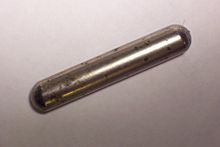Cage magnet
A cage magnet , formerly also known as a cow magnet or cow stomach magnet , is a strong magnet that is used to prevent foreign body disease in cattle. For this he is in the reticulum of cattle introduced, where he metallic foreign bodies that are falling behind with their feed intake in the digestive system binds, so that these are the gastric wall in rumen contractions can not hurt.
background
Cattle naturally consume large amounts of feed. Unlike sheep and goats , they are not very selective when it comes to eating. Metallic foreign bodies such as nails, pieces of wire, shavings and splintered parts of agricultural machines that are ingested with the food are often swallowed by the animals. Heavy foreign objects out here by their weight in the stomach under the entrance ( cardia lying) reticulum (hood) , the almost completely contracted within the framework of the hood rumen contraction. This can lead to the stomach wall being pierced by sharp foreign bodies, which can injure the surrounding internal organs and cause inflammation. As a result, the cow loses its appetite and thus produces less milk or does not increase its weight during fattening. The cage magnet is a very effective preventive measure against internal injuries caused by foreign objects.
construction
The cage magnet was developed in 1963 by Matthaeus Stöber at the University of Veterinary Medicine Hannover . Up until then, simple permanent magnets approximately as thick as a finger were in use, especially in the USA, which had the disadvantage that elongated foreign bodies protrude over the magnet like a hedgehog and thus continue to cause injuries.
The cattle clinic Hannover model developed by Stöber consists of a 15 centimeter long metal rod made of ferrite or the magnetic material Alnico with a diameter of approx. 3 cm, which is surrounded by a plastic cage. The cage has openings on the sides through which metal parts, which are attracted by the magnet, get into the interior of the cage. There they are held by the magnet so that they can no longer cause injuries to the stomach wall.
application
The cage magnet is inserted into the cattle's throat with the help of an applicator and its weight makes it into the reticulum stomach. The correct position of the magnet should be checked with a metal detector or a compass, as in rare cases it can also get into the rumen, where it does not offer any protection against damage to the hood.
The cage magnet remains in the reticulum until the end of its life. However, almost 4% of the applied cage magnets are lost because they are carried out of the stomach together with the mash when the cud is ruminated.
It is recommended to give young cattle a prophylactic cage magnet in order to prevent illness from iron parts remaining in the stomach before it develops.
See also
Individual evidence
- ↑ Dr. Kathrin Mahlkow-Nerge, Schleswig-Holstein Chamber of Agriculture online in Elite - Magazine for Cattle Producers (accessed on June 17, 2014)
- ↑ a b The cow's stomach holds even without nails and screws. In: The progressive farmer. Trade journal for the rural family. No. 9, May 1, 2003, ZDB ID 528498-3 , accessed on December 28, 2013.
- ↑ What are Cow Magnets?
- ↑ Gerrit Dirksen (Ed.): Diseases of the digestive organs and the abdominal wall. In: Gerrit Dirksen, Hans-Dieter founder, Matthaeus Stöber (ed.): Internal medicine and surgery of the cattle. 5th edition, unchanged reprint of the 4th edition. Parey, Stuttgart 2006, ISBN 3-8304-4169-X , pp. 357-696, here p. 412.
- ^ RE Carroll: The use of magnets in the control of traumatic gastritis of cattle. In: Journal of the American Veterinary Medical Association. Vol. 129, No. 8, October 15, 1956, ISSN 0003-1488 , pp. 376-378, PMID 13366840 .
- ↑ Katja Nuß: Veterinary medical instruments. Schattauer, Stuttgart et al. 1998, ISBN 3-7945-1794-6 , p. 89.
- ↑ Gerrit Dirksen (Ed.): Diseases of the digestive organs and the abdominal wall. In: Gerrit Dirksen, Hans-Dieter founder, Matthaeus Stöber (ed.): Internal medicine and surgery of the cattle. 5th edition, unchanged reprint of the 4th edition. Parey, Stuttgart 2006, ISBN 3-8304-4169-X , pp. 357-696, here p. 412
- ↑ Gerrit Dirksen, Internal Medicine and Surgery of Cattle , Georg Thieme Verlag, 2006, pp. 411–412 online at googlebooks


